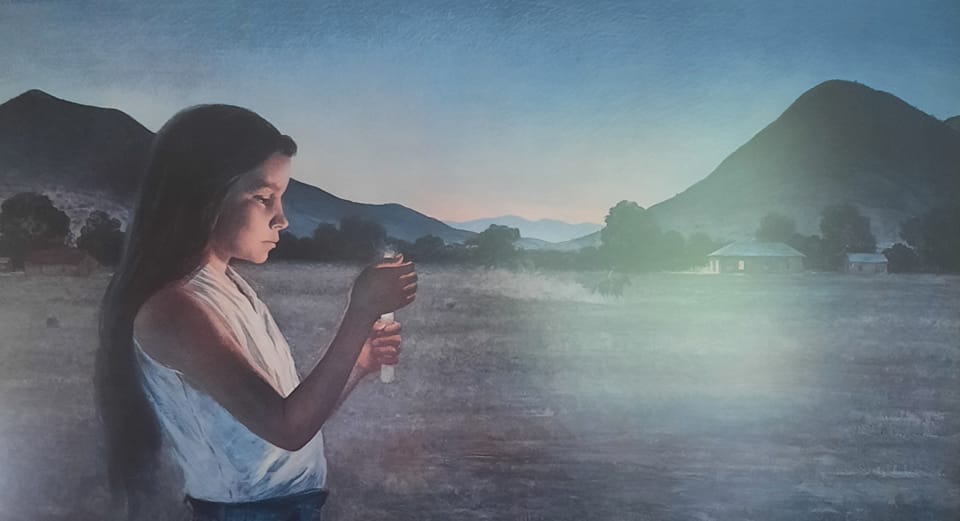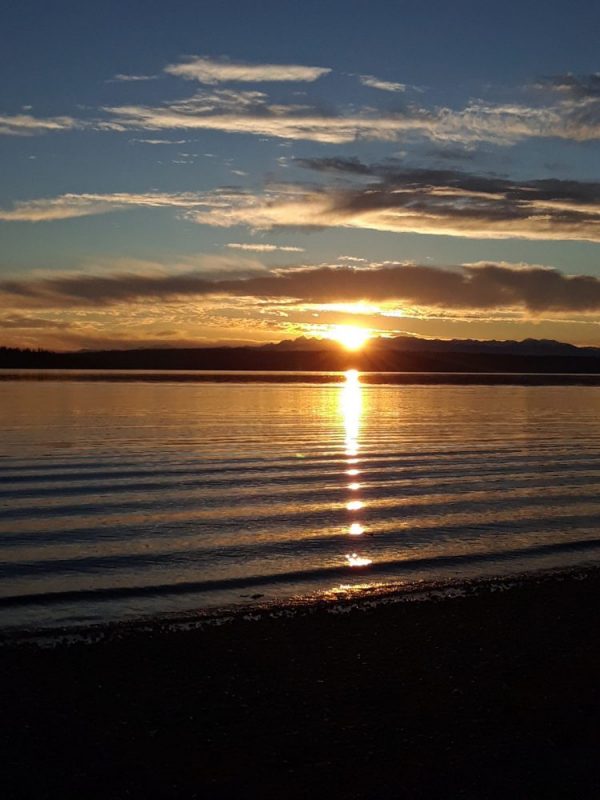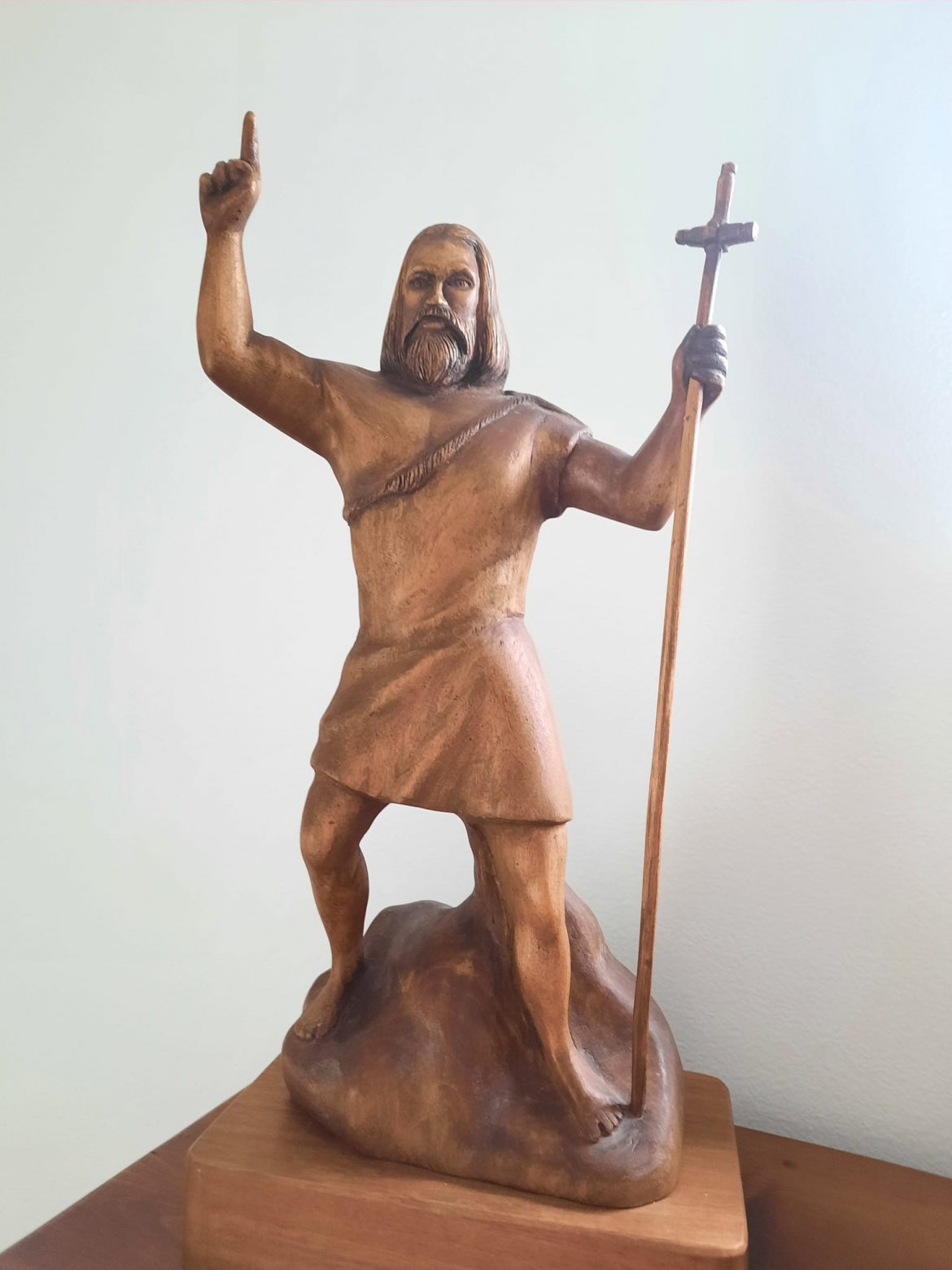On June 24, Christian churches around the world will mark the holy day of The Nativity of St. John the Baptist. Additionally, St. John’s Day will be celebrated in many countries as a public holiday.
The church celebrates his birth on this day as it falls six months before Christmas Day. According to the Gospel of Luke, his mother Elizabeth became pregnant six months before the angel Gabriel appeared to Mary announcing her miraculous conception. If you have never read the account of John the Baptist’s conception and birth, today would be a wonderful day to do that. (Luke 1:5-25)
Today is also a marvelous day to reflect on John’s ministry as an adult. My own reflections are guided by the pictured statue of John the Baptist. In 1996, a congregational member gifted me with this statue of the Baptist. She hired an artist to carve his likeness using walnut and oak. The artist used her thirty-four-year-old son’s face as a likeness for John’s face. I have spent hours contemplating on the ministry of John the Baptist through the lens of this work of art.
John was known as a provocative preacher calling others to repentance. As I look at the stature, I notice that John points a finger not at the crowds to rebuke them. Rather, he points toward heaven, proclaiming God and the coming of God’s kingdom. John’s mission was to herald the coming of the Messiah and this he did at the baptism of Jesus. The scriptures tell us that John was executed before the death of Jesus. And yet, I appreciate how the creator of the statue depicts John holding the cross of Christ, proclaiming what is to come historically.
John the Baptist is celebrated as a prophet and preacher. I also think of him as a pastor. He does this by offering us concrete ways to live out our roles as Christians. In my favorite sermon given by John recorded in the Gospel of Luke, John does just that.
“John the Baptist said to the crowds that came out to be baptized by him, ‘Bear fruits worthy of repentance.’ And the crowds asked him, ‘What then should we do?’ In reply he said to them, ‘Whoever has two coats must share with anyone who has none; and whoever has food must do likewise.’ (Luke 3:7, 8, 10-11)
Share your resources, be honest, resist violence. He calls for concrete neighbor-like love to be put into action. He sends the crowd home with the commandment to live their lives fully by practicing loving-kindness.
Interestingly, this day is also referred to as St. John’s Day, a major public holiday in the Western world. Celebrations are held on June 24 and also on the evening before. There will be celebrations in Spain, Portugal, Brazil, Ireland, Scotland, England and Northern Europe. There will be fireworks, parades and revelry and most notably bonfires. For many cultures, St. John’s Day has become a blend of Christian reverence, the celebration of the summer solstice and the midsummer festival.
 More simply, St. John’s Day were also quiet celebrations in the Southwest evidenced by this photo of a painting called, “Eve of St. John” by artist Peter Hurd (1904-1984) at his Sentinel Ranch, San Patricio, New Mexico.
More simply, St. John’s Day were also quiet celebrations in the Southwest evidenced by this photo of a painting called, “Eve of St. John” by artist Peter Hurd (1904-1984) at his Sentinel Ranch, San Patricio, New Mexico.
St. John’s Day is near the time of the summer solstice. It is likely that the Roman church fixed the Baptist’s day to distract the faithful from the summer solstice festivals. I have been delighted to do just the opposite. I have crafted a Christian church service which celebrates the ministry of John the Baptist together with a celebration of the summer solstice on the 23 or 24 of June.
I see no conflict in celebrating the fire of John’s preaching and legacy alongside celebrating the fire of the sun. And of course, my statue of John is placed on a pedestal for everyone’s contemplation followed by a bonfire outside to give thanks for the sun and longer days of light. It is good to celebrate the warmth of summer and the generosity of the Earth at this time of year in the Northern hemisphere.
Both John the Baptist and summer solstice celebrations celebrate the element of fire. Fire, for both Christians and creation-based spiritualities, represent repentance and cleansing; purification and protection. John the Baptist’s fiery sermons also equated fire with love.
Pierre Teilhard de Chardin (1881-1955) was an interesting French scientist, Jesuit priest, and mystic. He has won the distinction of being claimed as a contributor to the history of Celtic spirituality by John Philip Newell in his most recent book Sacred Earth, Sacred Soul. I think that the following poem by de Chardin does a brilliant job of holding together the two traditions of the Nativity of John the Baptist and St. John’s Day:
That first burst of Fire
from which we came
Love was its name and that
sacred Fire still burns
to create its magic in our hearts.
Someday, after we have
mastered the winds, the waves,
the tides and gravity,
we shall harness for God
the energy of love.
Then for the second time in the history of the world,
Humanity will have discovered
Fire. – Pierre Teilhard de Chardin, Toward the Future

As we celebrate this mystical time of year, let us pray that the Holy Spirit will fill our hearts with the fire of love and the justice of John the Baptist.
TOMORROW IS THE LAST DAY TO ENTER!
That’s right, Christine Sine is giving away two copies of her latest book, Digging Deeper: The Art of Contemplative Gardening!
June 24th is the last day for your entries to be counted! Click here for more information or visit tinyurl.com/DiggingDeeperGiveaway!
As an Amazon Associate I receive a small amount for purchases made through appropriate links. Thank you for supporting Godspace in this way.


